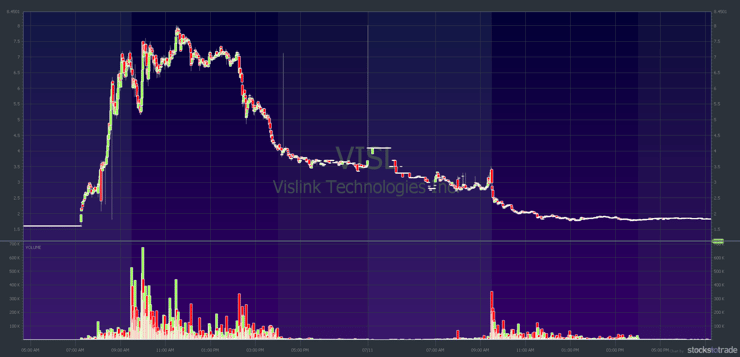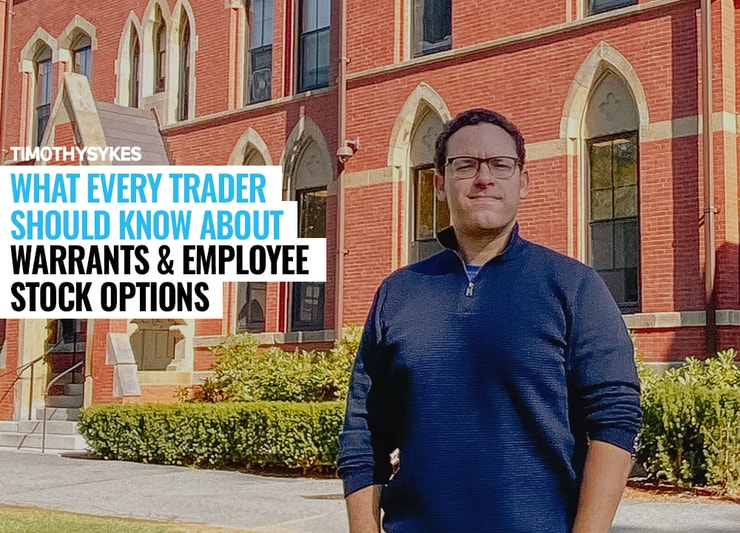I believe most penny stock companies are sketchy. I know that sounds bad, but I like transparency. If you assume most of these companies will fail, then you won’t fall for the hype…
The irony is, the sketchy nature of many micro-caps can create opportunities for traders. And there are two conflicting sides…
First, you have degenerate gamblers who buy anything spiking premarket. Or the chasers who haven’t learned not to buy overextended stocks. They say, “Oh, it’s gonna spike, it’s gonna spike.”
These traders are like hyenas in that famous children’s movie about lions…
Then you have the short-sellers. They say, “There are warrants, there are warrants.” They’re the party poopers — they short anything that’s up.
Trading Tip: You can potentially have a nice trading career living in between the two opposing sides. You just have to learn how you can take advantage of the situation. To learn all the nuances of trading, apply for the Trading Challenge now.
Which brings me back to stock options and warrants. Hint: Read to the end as I’ve included a recent case study — and it’s juicy…
Table of Contents
The Difference Between Stock Options and Warrants

2025 Millionaire Media, LLCBoth employee stock options (ESOs) and warrants give the owner the right to buy shares in the company. But there are some fundamental differences.
What’s an Employee Stock Option?
A stock option gives the employee the right, but not the obligation, to buy a set number of shares, at a set price, within a predetermined period of time.
For many employees of growth-stage companies, the stock option is the crème de la crème of compensation. Why? Because if they work hard and the company goes public, they stand to get a nice payout. Or, if it’s already a publicly traded company, their hard work might lead to an increase in share price. Either way, they have an incentive to work hard.
(Note: Sometimes these kinds of options are referred to as incentive stock options or ISOs.)
How Stock Options Work
Say, for example, you get a new job. Your pay package grants you 20,000 stock options that vest over four years, starting in year two. That means you can buy a certain number of shares each year at the strike price and sell them at the market price. Of course, you’d only do this if the current price was higher than your option strike price.
For our example, let’s say the strike price is $5 and the options vest like this:
- Year 2: 2,500 shares.
- Year 3: 2,500 shares.
- Year 4: 5,000 shares.
- Year 5: 10,000 shares.
And when it’s time to exercise your options in year two, the market price is $5.50. You decide to exercise the option — buying 2,500 shares at the $5 strike price and selling them all at the $5.50 market price. That’s a tidy profit of $1,250.
Some ESOs allow an exercise-and-sell option where you don’t even have to put up your own money. With this option, the brokerage handling the transaction covers your upfront costs.
You could also hold the options. But be aware that U.S. tax law requires you to exercise your ESOs within 10 years of issue.
The other alternatives are to exercise and cover, or do nothing. Exercise and cover means selling only enough shares to cover the purchase. You’d hold your remaining shares for potential future gains.
Key Stock Option Takeaway
The key thing to remember as we move on to warrants is that options give you the right to purchase existing shares. Because they already exist, they’re ‘priced in’ to the company’s share price.
More Breaking News
- Invest or Ignore? The Top Penny Stocks Ahead of Tariff Deadline
- Is It the Right Time to Buy CIFR Stock?
- Is Wolfspeed’s Downward Spiral Beyond Recovery?
What Are Warrants?
Stock warrants, issued by the company, give the holder the right to buy shares directly from the company. When warrants are exercised, shares are added to the float.
Now we descend into the murky depths…
Remember: Your focus should be on learning how things work. Why? So you can learn how to potentially take advantage of market inefficiency.
Also, I’ve simplified things for this post. There are varieties of warrants and stock options. For trading purposes, especially short selling, you should understand warrants. This post is only a start. You also need to learn to read Securities and Exchange Commission (SEC) filings.
For that, my joint DVD with Michael Goode is a must. Get it here: Read SEC Filings.
(Note: I don’t read SEC filings for every trade. Especially intraday trades. To understand when and why I study SEC filings, see this edition of the Millionaire Mentor Update.)
How Warrants Work
Warrants are technically similar to options. But there are some key differences.
How Stock Options and Warrants Differ
- Warrants are issued directly by the company.
- They’re tied to an underlying security that doesn’t yet exist.
- Because warrants are tied to nonexistent securities, they’re dilutive.
- Warrants are often attached to new shares offered in a financing.
Now let’s take a look at each difference in a little more detail…
Warrants Are Issued By the Company
Companies issue new stock and stock warrants to raise capital. While we’d all like to think raising capital means the company can continue R&D on their latest world-changing invention…
… too often it’s a sign the company has little cash, minimal revenue, and needs the financing to keep the lights on. Or to pay the executive salaries. Screw being nice — it’s usually to pay the executive salaries and consulting fees.
So, for example, say yesterday a company’s float was 10 million shares. Today 2 million new shares appear on the market after warrants are exercised. Now there are 12 million shares.
What do you think that does to the price of the stock? Let’s say the company had a market capitalization of $10 million. Prior to the new shares hitting the market, each share was worth $1. But now there are 12 million shares.
Is the company worth $12 million?
Warrants Are Dilutive
Without something to drive the price up, the answer is no. All things being equal, the share price would drop to 83.3 cents per share. ($10 million divided by 12 million shares equals .833 or 83.3 cents per share.) This is what I mean when I say warrants are dilutive.
Warrants and SEC Filings

2025 Millionaire Media, LLCIf you’re wondering about the legality of warrants … I assure you, they’re legal. Sketchy? Likely. Even ethically questionable once you see how they work, but legal.
So long as the company reports the warrants properly, they’re fair game.
This is where market inefficiency comes into play. Most people won’t take the time to read the filings. Instead, they’ll read the email from the pumper, verify it on Twitter, and then call their broker and order a few thousand shares before the ‘next Microsoft’ launches them into the top 1%…
OK, I’m being facetious. Like I said, the company is required to report the creation of warrants. What’s the best way to let the world know what you’re doing without jeopardizing your chance to raise capital?
Bury it in an SEC filing. The first thing to look for if you’re wondering about new shares is an S-1 filing. The S-1 is a registration of new shares with the SEC. It’s required before the shares can be traded on an exchange.
But to really get a clear picture, you need to dig further…
Look for information on how the shares will be offered. What’s the exact number? Will there be warrants? What’s the exercise price? You can find this information in SEC form 424B4 — which is an update to the prospectus filed before the IPO.
Pump It Up, Baby!
When a company needs to raise money, one option is to increase the number of shares. This requires approval by the board of directors. When the stock price is right, they sell the shares on the open market.
Which means…
When you see a company with an S-1 filing, they’re offering new shares. Any such offering dilutes the value of existing shares. Why? Because the public float increases by the number of new shares sold. I’ll show an example in a moment.
When you add warrants to the mix, it only gets more complex and sketchy. That’s because the warrant holder has the right to purchase shares at a set price, but the shares don’t exist until the warrants are exercised.
Again, the Read SEC Filings DVD is a must. Once you go through the DVD, you’ll still need to spend time doing it to get better at it. Like every other aspect of trading, it takes time and effort.
VISL: A Case Study in Toxic Dilutive Financing
Before I delve into the details, I want to be clear: this is a rough overview. Why only an overview? Because once you start digging, it’s like going down a rabbit hole. And once you enter the rabbit hole, it’s soon clear that every tunnel leads to more dark tunnels.
Name Changes, Reverse Splits, and Offerings: Welcome to the Dark Side
Formerly known as xG Technology, Vislink Technologies, Inc (NASDAQ: VISL) is like a poster child for toxic financing.
How xG Technology Became Vislink Technologies
Back in February 2017, xG Technology acquired Vislink from Pebble Beach Systems Group, plc. (Plc means public liability company — the British version of a publicly traded company.) The deal was worth $6.5 million in cash and $9.5 million in promissory notes.
The sale of Vislink to xG was a divestment. It meant Pebble Beach Systems Group could transition to a software-based strategy. To emphasize xG Technology’s awful track record, they didn’t actually pay the full agreed amount…
With $4.9 million still due to Pebble Beach, there was a settlement for $2 million in cash. xG Technology also paid off some of Pebble Beach’s creditors as part of the deal.
You can’t make this stuff up.
So, why did xG Technology adopt the Vislink name? I can only guess. But considering the dire state of xG Technology’s finances and…
… its history of dilutive financings and reverse stock splits…
… maybe they wanted to re-brand.
A fresh name and a fresh look for investors. (I‘m trying to give them the benefit of the doubt, but it’s sketchy as hell.) Even though Vislink was struggling, it sold real products with a history of profit. Plus, Vislink plc was a U.K.-based company. That means it wouldn’t be on the average U.S. investor’s radar.
Back to xG Technology…
Reverse Splits Can Signal Trouble
Trading under the ticker XGTI, the company had three reverse stock splits from 2015 to 2018.
Why does a company do a reverse split? So they can prop up the share price. For example, Nasdaq issues a notice of delisting when a company’s share price remains below $1 for more than 30 days.
They give the company time to get the share price up. The company can apply for a 180-day grace period. A second 180-day grace period is sometimes offered, as well.
If the company can’t get the price back up through positive earnings or other good news, they might resort to a reverse split.
What Happened With the XGTI Reverse Splits
I’ll put it in the simplest and kindest terms…
If you invested $10,000 in shares of XGTI at the company’s inception in 2012, you’d have lost 99.94% by the time of its ‘rebranding’ to VISL. Your $10K investment would’ve been worth $5.77.
If that’s not enough to tell you this company had questionable tactics, they went and did another reverse split. By means of a 1-for-10 reverse split that took effect on May 13, 2019, they managed to remain listed on the Nasdaq.
I’ve left out sooooo much because this could go on forever.
Before the Latest Toxic Financing … A Brief Lesson in Corporate Slime
After you study the Read SEC Filings DVD, start digging. Remember, your goal is to understand the two sides of the equation. You might be surprised at what you find.
As a teaser, I’ll give you one example…
Three members of the Vislink board of directors — including the current and former CEO — also served on the board of MB Technology Holdings, LLC (MBTH).
MBTH was a privately held company created to provide ‘certain management and financial services’ to Vislink. What did they get in return? Fees, of course. Big fat fees.
This from the Vislink Technologies 10K (annual statement). Emphasis is mine:
“The Company has agreed to award MBTH a 3% cash success fee if MBTH arranges financing, a merger, consolidation or sale by the Company of substantially all of its assets. On November 29, 2016, the Company and MBTH entered into an acquisition services agreement (the ‘M&A Services Agreement’) pursuant to which the Company engaged MBTH to provide services in connection with merger and acquisition searches, negotiating and structuring deal terms and other related services.”
That agreement was superseded by the current arrangement with MB Merchant Group, LLC. The current Vislink CEO and the other co-founder are the only officers of MBMG. The fee for arranging takeovers of other companies stands. How much? Their fee is a minimum of $250K and a maximum of $10.2 million plus 1.1% of the transaction. I’ll let that sink in…
As you can see, MBMG has the potential to clean up if another merger/acquisition completes. They already made a fair chunk from the Vislink acquisition.
But wait … it gets better…
“Additionally, MBMG will receive a monthly fee of $50,000, and the Company at its sole discretion will have the option to credit such fees against future acquisition fees due each year to the extent it deems that appropriate based on all services received from MBMG.”
All this for a company losing money hand over fist — to the tune of $14 million for the year ended December 31, 2018. Their last quarterly report put them on track to lose a similar amount in 2019.
Keep in mind, they paid the CEO a salary of $293,800 in 2018. Add the stock options, and he was compensated $491,288.
Sketchy, sketchy, sketchy…
Finally, the latest round of toxic financing…
VISL Completes Offering Raising $12 Million

2025 Millionaire Media, LLCWe’re almost back to the present. Remember, on May 10, the company announced a 1-for-10 reverse stock split. When the market opened on May 13, the stock price was $2.44 after closing at $0.2435 on May 10.
Then, on June 3, Vislink put out this press release announcing $650,000 in orders for its airborne video downlink service. This news spiked the stock from $1.62 to a high of $3.74 before settling to close at $2.97. Unfortunately, the spike was a one-day event and the stock gapped down overnight.
On June 17, VISL spiked again. This time, they piggybacked a press release off of this article about the OGN Super Arena in Manhattan Beach, California. What is it? An Esports venue. Vislink got a mention because their transmitter is being used in the arena.
July 1 was notable because it signaled more share dilution. How? Vislink filed an S-1 with the SEC. That means more shares were on the way. Something big was coming…
Finally, we arrive at the big day … July 10, 2019.
- At 3 a.m., Vislink filed an S-1/A. The A means there’s an amendment to the S-1 filed on July 1. What was the amendment? The first filing didn’t fill in all the blanks. It wasn’t clear how many shares would be offered.
- Then, at 7:15 a.m., a press release announced Vislink was awarded a $2.8 million contract with the U.S. Army. It was a big news catalyst and led to a massive pre-market spike.
- After closing the previous day at $1.65, the stock opened at $6.58. Was it a pump? In my opinion, the pre-market frenzy combined with aggressive shorts created a bigger spike than the news warranted. The stock ran all the way to a high of $8 per share.
But Vislink once again proved itself incapable of holding the spike, dropping back to $4.10 per share at the close.
Check out the chart…

Now take a look at the chart from July 10 and 11:

At last, we get to the offering…
At 6:18 p.m. on July 10, Vislink finalized the new share offering for 7.27 million shares and pre-funded warrants. It gets slightly complicated, but the end result was that the company raised approximately $12 million, which they used to pay off convertible debt.
Interesting note: 1,000,000 shares of common stock issuable upon exercise of pre-funded warrants were purchased by someone previously sued for a fraudulent takeover scheme. It was a big payday for that person.
Sketchy? I’ll let you decide.
Mind you, the company’s total loss since inception is roughly $240 million. They’re still losing money hand over fist. The CEO and his fellow directors are raking in the cash. What of the investors… those poor souls who buy the hype… the bagholders? All I can do is shake my head.
Trading Challenge
The circumstances explained in this post aren’t uncommon. If you want to become a better trader, understanding how toxic financing works is part of the game. But there’s more you need to know to help you get consistent.
That’s why I’ve created the Trading Challenge. It’s a super-comprehensive program giving you access to thousands of video lessons, hundreds of hours of DVD instruction, and several years worth of archived webinars. If you’re ready to get to work, apply today.
Are you a trader? What’s your experience with warrants and toxic dilutive financings? New to trading? What have you learned in this post that will help you as a trader? Comment below, I love to hear from all my readers!











Leave a reply